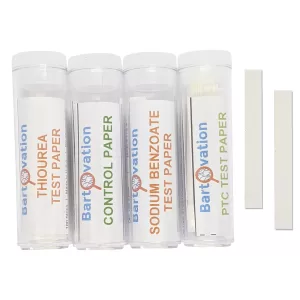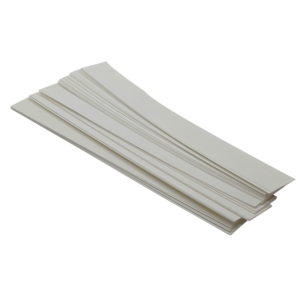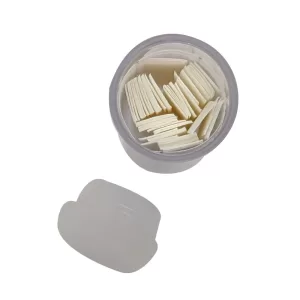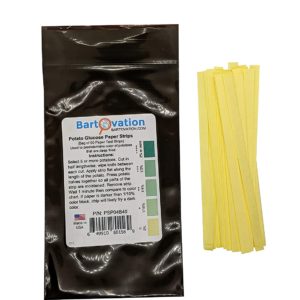Description
- The strip can be used to measure glucose levels in osmosis/diffusion experiments and food science studies.
- UV Resistant Bag of 40 Paper Test Strips
- Color chart has blocks at 0, .1, .25, .5, and 2% Glucose
- Strips can be cut in half – doubling the number of tests you can do per bag!
The strip can be used to measure glucose levels in osmosis/diffusion experiments and food science studies. These strips are specific to glucose. You will not get a reaction with soft drinks or regular sugar since these are mainly fructose or sucrose.
The strips are sensitive enough to detect the glucose from the breakdown of starch.
These strips are not intended for medical diagnosis or for testing glucose in urine.
Instructions
- Remove one test paper from the bag using tweezers. Do not touch the test paper with your bare hand. The strip is 4 inches in length, and may be cut into smaller lengths if needed.
- Dip the test strip into the solution being tested for 1-2 seconds.
- Remove the strip from the solution.
- After 60 seconds, compare the test strip to the color chart.
NOTE: In solutions containing oxidizers, a false positive may be observed.
NOTE: The glucose test strips use an enzyme that is specific for glucose. In order for the enzyme to work properly, the glucose needs to undergo mutarotation. Ensure the glucose has been dissolved in the water solution for at least 3 hours, to ensure that the mutarotation process has occurred.
Frequently Asked Questions (FAQ)
The test did not respond to table sugar (sucrose). Why?
The test strips are designed to detect glucose specifically. Table sugar (sucrose) is not detected because the enzyme used in the test is selective for glucose. Sucrose, along with other sugars like fructose or galactose, does not react with the test strips, meaning no response will occur if these are present.
What do these test strips measure?
These test strips measure glucose levels in liquids, specifically detecting glucose concentrations between 0 and 3000 mg/dL. They are designed to be used in osmosis or diffusion experiments, as well as food science studies. The strips use an enzyme specific to glucose, so they will only give accurate readings for glucose and not for other types of sugars.
The test did not respond to glucose. Why?
The test may not have responded to glucose if the solution did not allow the glucose to undergo mutarotation, which can take up to 3 hours in water samples. If you tested a food or liquid sample and didn’t wait long enough for this process, the enzyme might not have had time to properly react with the glucose. Additionally, other chemicals or interference from Vitamin C could have affected the test results.
Can the glucose test strips be used to test food samples?
Yes, the glucose test strips can be used to measure glucose levels in food samples, but there are a few important considerations:
1. The strips are specific to glucose, so other sugars like fructose or sucrose will not be detected.
2. Certain chemicals, such as Vitamin C, can interfere with the results.
3. The glucose needs to undergo mutarotation (which may take up to 3 hours), especially if the sample is a liquid.
Thus, while the strips can be used for food, the sample needs to be suitable and processed correctly for accurate results. We recommend standardizing and validating any procedure for testing food.


![Scientific Glucose Test Paper Strips <span class="bldppm">0-2%</span> [Bag of 40 Paper Strips] for Food Science or Osmosis/Diffusion Experiments](https://bartovation.com/wp-content/uploads/2020/03/PSP04B40-PHOTO-MAIN.jpg)
![Scientific Glucose Test Paper Strips <span class="bldppm">0-2%</span> [Bag of 40 Paper Strips] for Food Science or Osmosis/Diffusion Experiments - Image 2](https://bartovation.com/wp-content/uploads/2020/03/PSP04B40-PHOTO-3.jpg)
![Scientific Glucose Test Paper Strips <span class="bldppm">0-2%</span> [Bag of 40 Paper Strips] for Food Science or Osmosis/Diffusion Experiments - Image 3](https://bartovation.com/wp-content/uploads/2020/03/PSP04B40-PHOTO-2.png)
![Scientific Glucose Test Paper Strips <span class="bldppm">0-2%</span> [Bag of 40 Paper Strips] for Food Science or Osmosis/Diffusion Experiments - Image 4](https://bartovation.com/wp-content/uploads/2020/03/PSP04B40-PHOTO-4.jpg)
![Scientific Glucose Test Paper Strips <span class="bldppm">0-2%</span> [Bag of 40 Paper Strips] for Food Science or Osmosis/Diffusion Experiments](https://bartovation.com/wp-content/uploads/2020/03/PSP04B40-PHOTO-MAIN-100x100.jpg)
![Scientific Glucose Test Paper Strips <span class="bldppm">0-2%</span> [Bag of 40 Paper Strips] for Food Science or Osmosis/Diffusion Experiments - Image 2](https://bartovation.com/wp-content/uploads/2020/03/PSP04B40-PHOTO-3-100x100.jpg)
![Scientific Glucose Test Paper Strips <span class="bldppm">0-2%</span> [Bag of 40 Paper Strips] for Food Science or Osmosis/Diffusion Experiments - Image 3](https://bartovation.com/wp-content/uploads/2020/03/PSP04B40-PHOTO-2-100x100.png)
![Scientific Glucose Test Paper Strips <span class="bldppm">0-2%</span> [Bag of 40 Paper Strips] for Food Science or Osmosis/Diffusion Experiments - Image 4](https://bartovation.com/wp-content/uploads/2020/03/PSP04B40-PHOTO-4-100x100.jpg)




